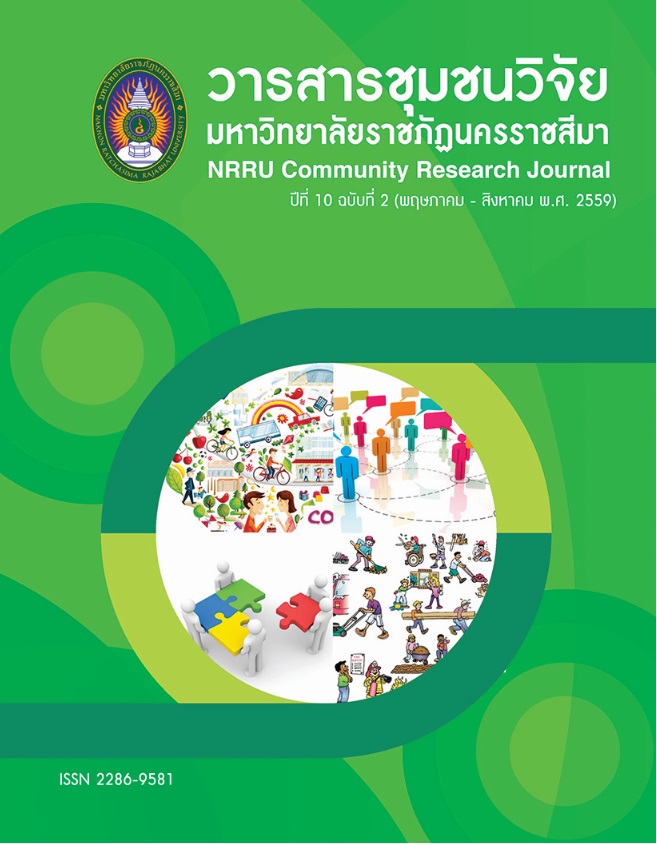ศึกษาการผลิตผงสีจากใบตะเคียนหนูสำหรับการพิมพ์สกรีน เพื่อเพิ่มมูลค่าผลิตภัณฑ์ผ้าทอน้ำมอญ
คำสำคัญ:
ผงสี, ใบตะเคียนหนู, หมึกพิมพ์สกรีน, ผ้าทอน้ำมอญ, Pigment, Anogeissus Acuminata, Nam Morn Weaving Cottonบทคัดย่อ
ในปัจจุบันอุตสาหกรรมการพิมพ์สกรีนมีบทบาทสำคัญในการพัฒนาความก้าวหน้าแต่หมึกพิมพ์โดยทั่วไปจะมีตัวทำละลาย จึงส่งผลเสียต่อสุขภาพเนื่องจากมีกลิ่นเหม็น หมึกพิมพ์ที่เหลือกำจัดได้ยาก ผู้จัดทำจึงมีวัตถุประสงค์เพื่อศึกษากรรมวิธีการผลิต ผงสีธรรมชาติจากใบตะเคียนหนูสำหรับเป็นสารให้สีในหมึกพิมพ์สกรีน ทดสอบคุณสมบัติของหมึกพิมพ์สกรีนและเป็นทางเลือก ในการพิมพ์ลวดลายจากหมึกพิมพ์ธรรมชาติและเพิ่มมูลค่าให้กับ ผลิตภัณฑ์ผ้าทอน้ำมอญ โดยมีวิธีการศึกษากำหนดกรรมวิธีการ ผลิตหมึกพิมพ์จากใบตะเคียนหนู 3 วิธี คือ วิธีที่ 1 นำใบตะเคียนหนูมาผสมน้ำกลั่นปั่นและนำไปบดด้วยเครื่อง Ball Mill แล้วนำเข้าตู้อบความร้อนเพื่อไล่ความชื้น วิธีที่ 2 นำใบตะเคียนหนูม าผสมน้ำกลั่นปั่น และกรองน้ำออกเหลือเพียงใบตะเคียนหนู แบบเปียก นำไปเข้าตู้อบเพื่อไล่ความชื้น แล้วนำไปบดด้วยเครื่อง Ball Mill วิธีที่ 3 นำใบตะเคียนหนูมาผสมน้ำกลั่นปั่น และกรองน้ำออกเหลือเพียงใบตะเคียนหนูแบบเปียก นำไปบดด้วยเครื่อง Ball Mill แล้วนำไปเข้าตู้อบความร้อนเพื่อไล่ความชื้น หลังจากนั้นเตรียมสารละลายพอลิไวนิลแอลกอฮอล์ แป้งมันสำปะหลัง และผงสีจากใบตะเคียนหนูร้อยละ 25 ทำให้เป็น หมึกพิมพ์สกรีนสำหรับนำมาพิมพ์สกรีนบนผ้าทอน้ำมอญ และวิเคราะห์คุณภาพทางด้านงานพิมพ์ ผลการทดลองพบว่า กรรมวิธี ผลิตหมึกพิมพ์สกรีนจากใบตะเคียนหนูกรรมวิธีที่ 2 ดีที่สุด เนื่องจากลักษณะหมึกพิมพ์มีความหนืดรวมตัวเป็นเนื้อเดียวกัน ไม่แยกชั้นเพราะลักษณะอนุภาคของหมึกพิมพ์มีขนาดที่เล็ก สำหรับการทดสอบคุณภาพงานพิมพ์ประกอบไปด้วย ตัวอักษร พอสิทีฟ เนกาทีฟ เส้นพอสิทีฟ เนกาทีฟ ภาพลายเส้นและภาพพื้นทึบ พบว่า ให้คุณภาพเหมาะสมที่สุดเพราะขนาดของตัวอักษร สามารถมองเห็นชัดเจน ไม่มีรอยแตกบริเวณขอบตั้งแต่ 18 pt. ลักษณะเส้นคมชัด ภาพลายเส้นและภาพพื้นทึบมองเห็น รายละเอียดทุกส่วนของภาพชัดเจนเนื่องจากสามารถพิมพ์ลงเต็มพื้นที่บริเวณภาพ
A STUDY OF PIGMENT FROM ANOGEISSUS ACUMINATA FOR SCREEN PRINTING TO MAKE THE VALUE-ADDED NAM MORN WEAVING COTTON
At present, a screen printing industry has an important role to develop a printing progress but Importantly, the printing ink which generally used is produced from synthetic colors. So, the printing ink which is a solvent is harmful to health because of offensive smell and the rest of printing ink is difficult to eliminate. For these reasons, the researcher had a purpose to study the production method of natural pigment from Anogeissus Acuminata to make it as a pigment for the printing ink. The next two purposes were to test the quality of the screen printing ink and to offer the alternative of pattern printing by using natural screen printing ink to make the value-added Nam Morn weaving cotton. The researcher conducted 3 methods of producing the printing ink from Anogeissus Acuminata. The first method was mixing the Anogeissus Acuminata with distilled water, blending and grinding it with a ball mill. The following step was putting it in a hot air oven in order to get rid of moisture. The second method was mixing the Anogeissus Acuminata with distilled water, blending, filtering and keeping the soak Anogeissus Acuminata and then putting it in the hot air oven in order to get rid of moisture and next grinding it with the ball mill. The third method was mixing the Anogeissus Acuminata with distilled water, blending, filtering and keeping the soak Anogeissus Acuminata. Then, the researcher ground it with the ball mill. After that, PVOH, cassava flour and 25% of pigment from Anogeissus Acuminata were prepared and then heated them up until they turned into the printing ink for the Nam Morn weaving cotton and followed by analyzing the printing and textile quality. From the study, it was found that the 2nd method was the best because sticky and homogeneous printing ink could not laminate. It can be said that small particles of printing ink met the printing quality which was composed of positive-negative letters, positive-negative lines, outline and solid. It showed from the 2nd method that the size of letters could be seen clearly, no cracks at the edge from 18pt. The sharpness of the lines was every detail of outline and solid also could be seen clearly.



